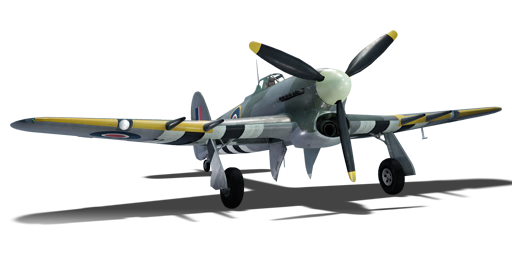


The Typhoon Mk Ib is a premium gift British fighter. It has been in the game as a premium pack since the start of the Open Beta Test prior to Update 1.27 but was removed from the store after the 2017 Winter Sale. It has since been made available for purchase with Golden Eagles for the 2018 "Royal Air Force Centenary", the 2020 D-Day, the 2023 "Royal Air Force Day", and the 2024 "Anniversary of the Royal Air Force" mini-events. It also has been made available again in the store episodically for the 2018 Winter Sale, the 2020 "80th Anniversary of the Battle of Britain" event and as part of the 2020 and 2021 D-Day Sales.
While the Typhoon Mk Ib is slightly inferior compared to the Mk Ib/late in regards to flight performance and engine power, the main difference from the Mk Ia is the vastly upgraded armament options, including 4 x 20 mm Hispano Mk II cannons and larger bombs and rockets.
flaps
flaps
flaps
brake
| Belt | Belt filling | Armor penetration (mm) at a distance: | |||||
|---|---|---|---|---|---|---|---|
| 10 m | 100 m | 500 m | 1000 m | 1500 m | 2000 m | ||
| HEI/SAP-I/T | 22 | 20 | 14 | 9 | 6 | 4 | |
| AP-T/HEI/SAP-I | 37 | 35 | 25 | 16 | 10 | 7 | |
| T/HEI/SAP-I/HEI/SAP-I | 22 | 20 | 14 | 9 | 6 | 4 | |
| AP-T/T/HEI | 37 | 35 | 25 | 16 | 10 | 7 | |
| AP-T/SAP-I/HEI/AP-T | 37 | 35 | 25 | 16 | 10 | 7 | |
| HEI/HEI/SAP-I | 22 | 20 | 14 | 9 | 6 | 4 | |







 2 x (55 / 175 / 270) %
2 x (55 / 175 / 270) % 
 2 x 136 %
2 x 136 % 

Flight performance | |
|---|---|
Survivability |
|---|
Weaponry | |
|---|---|